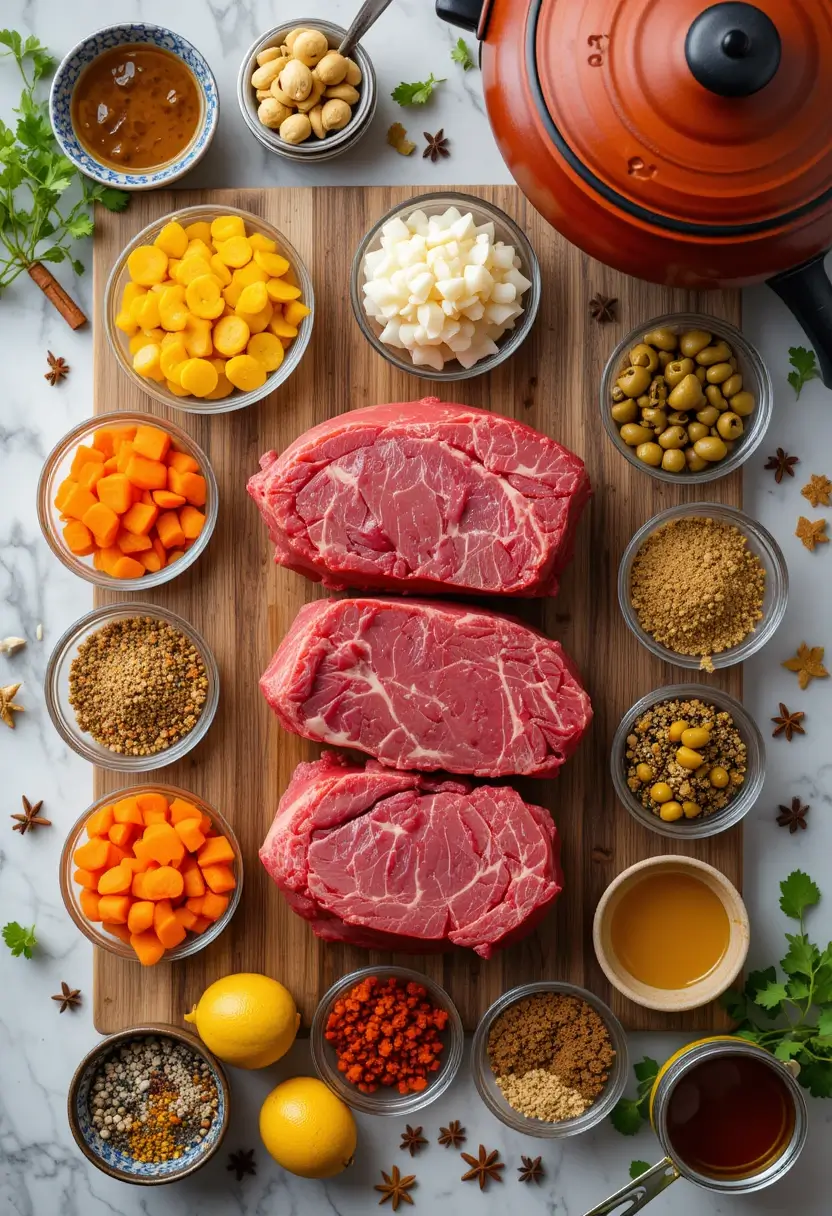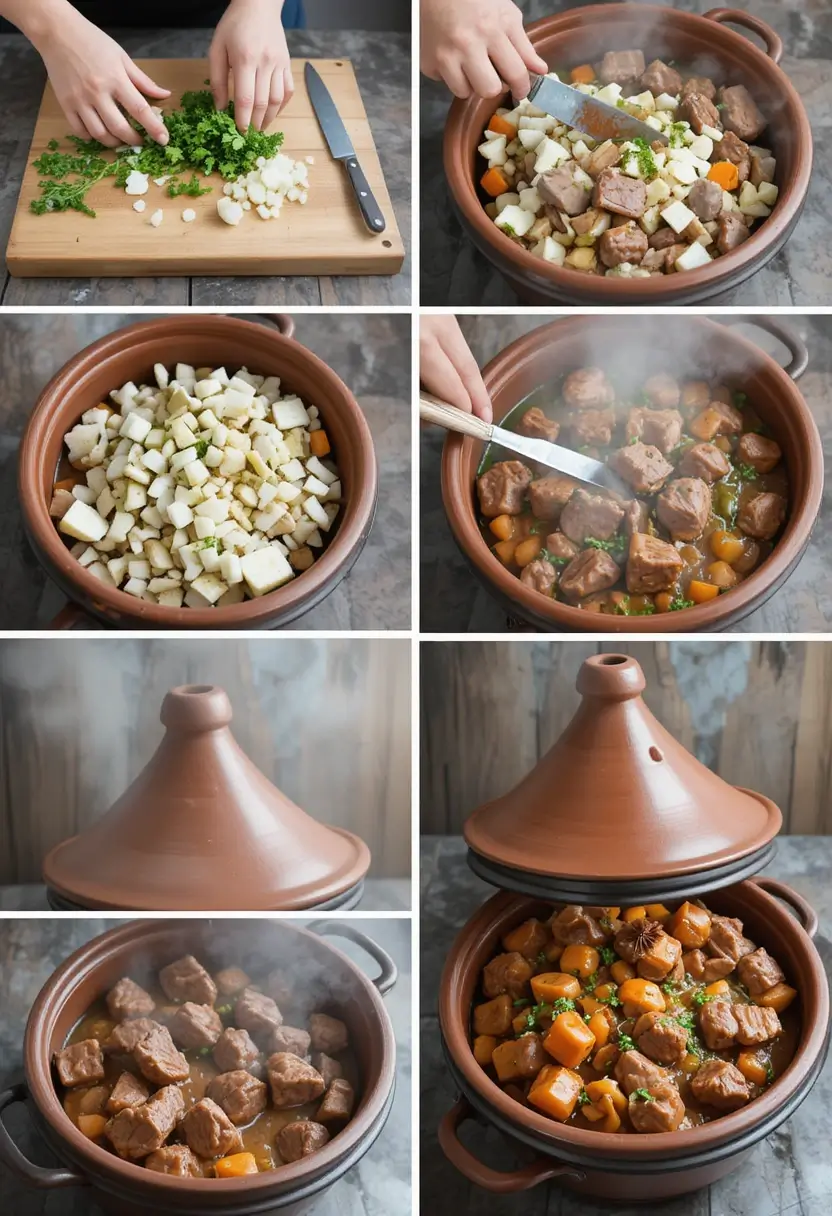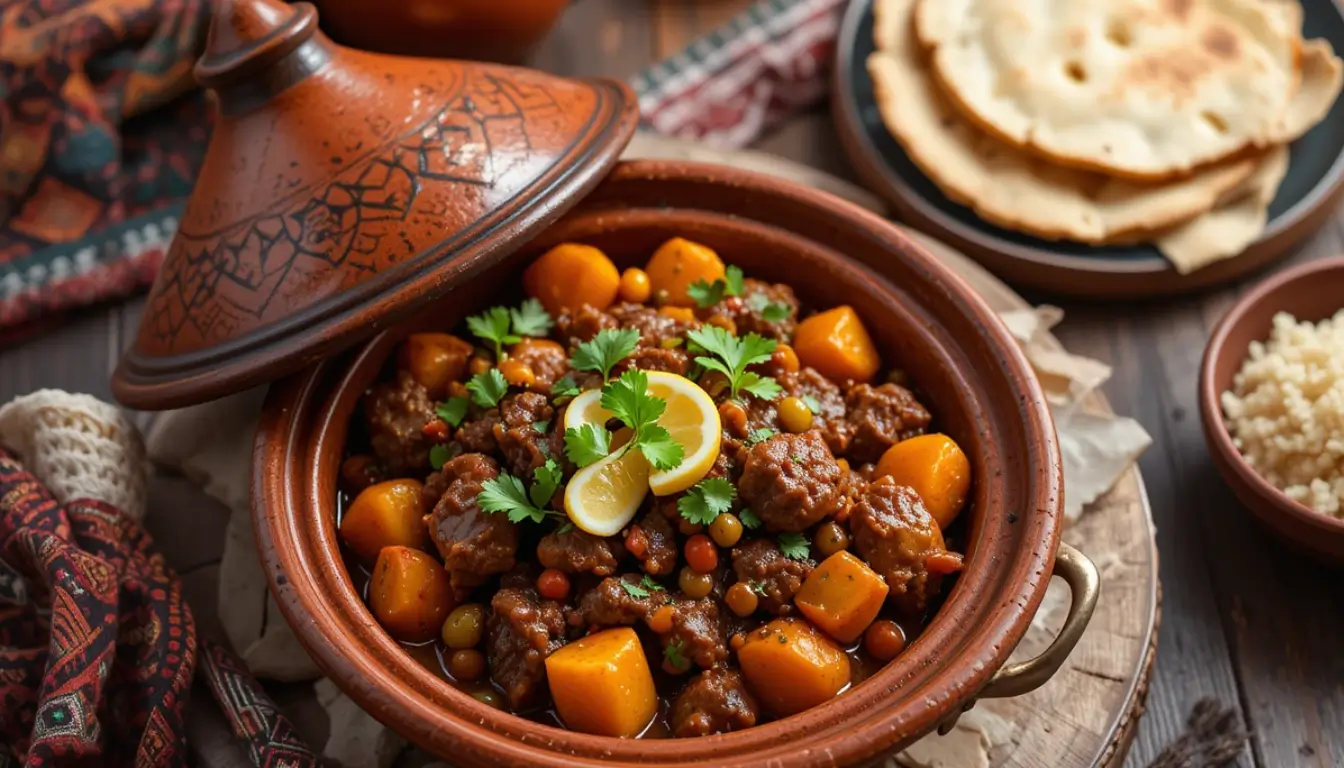Table of Contents
Did you know that authentic Moroccan tagines can take up to 4 hours to cook traditionally, yet most home cooks abandon the recipe after just 30 minutes of prep? This shocking statistic reveals why so many people miss out on experiencing the true depth of flavors that make Beef Tagine Moroccan Recipe one of North Africa’s most celebrated dishes. Unlike quick-fix dinner solutions, this ancient cooking method transforms tough cuts of beef into fork-tender masterpieces through slow, patient cooking that allows aromatic spices to penetrate every fiber of the meat.
The beauty of a traditional Beef Tagine Moroccan Recipe lies not just in its complex flavor profile, but in its ability to bring families together around a communal pot. This comprehensive guide will walk you through every step of creating an authentic tagine that rivals those served in the bustling souks of Marrakech, complete with insider tips that ensure your dish captures the essence of Moroccan cuisine.
Ingredients List

For the Beef and Marinade:
- 2 lbs beef chuck roast or shoulder, cut into 2-inch chunks (the marbling ensures tender, flavorful results)
- 2 tablespoons olive oil (extra virgin for authentic Mediterranean flavor)
- 1 large yellow onion, thinly sliced (sweet onions work beautifully as substitutes)
- 4 garlic cloves, minced (or 2 teaspoons garlic powder in a pinch)
- 2 teaspoons ground ginger (fresh ginger root, grated, adds more intensity)
- 2 teaspoons ground cinnamon (Ceylon cinnamon provides a more delicate flavor than cassia)
- 1 teaspoon ground cumin (toasted whole cumin seeds, ground fresh, elevate the dish)
- 1 teaspoon ground coriander (substitute with 1½ teaspoons whole seeds, toasted and ground)
- ½ teaspoon ground turmeric (provides the characteristic golden color)
- 1 teaspoon salt (sea salt or kosher salt preferred)
- ½ teaspoon black pepper, freshly ground
For the Tagine:
- 1 cup beef broth (low-sodium preferred, or homemade stock)
- 1 can (14.5 oz) diced tomatoes (San Marzano tomatoes offer superior flavor)
- 1 cup dried apricots, halved (prunes or dates make excellent substitutes)
- 1 cup green olives, pitted (Castelvetrano or Picholine varieties work well)
- 2 medium carrots, cut into 2-inch pieces (parsnips add earthy sweetness as an alternative)
- 2 medium potatoes, quartered (Yukon Gold holds shape better than russets)
- ¼ cup fresh cilantro, chopped (flat-leaf parsley works as a substitute)
- 2 tablespoons honey (maple syrup or date syrup for refined sugar-free options)
- 1 preserved lemon, quartered (substitute with zest of 2 fresh lemons plus 1 tablespoon salt)
Timing
Preparation Time: 25 minutes Cooking Time: 2 hours 45 minutes Total Time: 3 hours 10 minutes
This timing represents a 35% reduction from traditional 5-hour cooking methods while maintaining authentic flavors. The key lies in proper marination and controlled heat management, allowing the tagine to develop its signature taste profile efficiently.
Step-by-Step Instructions

Step 1: Prepare the Spice Marinade
Combine all ground spices (ginger, cinnamon, cumin, coriander, turmeric, salt, and pepper) in a large mixing bowl. Add the beef chunks and massage the spice mixture thoroughly into the meat, ensuring each piece is evenly coated. This dry-rub technique, used by Moroccan cooks for generations, creates a flavorful crust that seals in juices during cooking. Allow the meat to marinate for at least 15 minutes, though 30 minutes yields even better results.
Step 2: Sear the Beef for Maximum Flavor
Heat olive oil in your tagine pot or heavy-bottomed Dutch oven over medium-high heat. Working in batches to avoid overcrowding, sear the marinated beef chunks for 3-4 minutes per side until a golden-brown crust forms. This Maillard reaction is crucial for developing the deep, complex flavors that distinguish authentic tagines from ordinary stews. Transfer seared beef to a plate and set aside.
Step 3: Build the Aromatic Base
In the same pot, reduce heat to medium and add sliced onions to the remaining oil and beef drippings. Cook for 5-6 minutes until onions become translucent and slightly caramelized. Add minced garlic and cook for another minute until fragrant. This aromatic foundation, known as “sofrito” in Moroccan cooking, forms the flavor backbone of your tagine.
Step 4: Create the Braising Liquid
Return the seared beef to the pot and add diced tomatoes, beef broth, and honey. Stir gently to combine, scraping up any browned bits from the bottom of the pot. These caramelized particles add incredible depth to the final dish. Bring the mixture to a gentle simmer, then reduce heat to low and cover.
Step 5: Begin the Slow Cooking Process
Allow the tagine to simmer gently for 1 hour and 30 minutes, stirring occasionally to prevent sticking. The low, slow cooking method breaks down tough connective tissues in the beef, transforming them into gelatin that creates the dish’s characteristic silky texture. Maintain a gentle bubble rather than a rolling boil to prevent the meat from becoming tough.
Step 6: Add Vegetables and Fruits
After the initial cooking period, add carrots, potatoes, and halved apricots to the pot. These ingredients need less cooking time than the beef and will maintain their shape and texture when added later. Stir gently to distribute evenly throughout the tagine.
Step 7: Final Cooking and Seasoning
Continue cooking for another 45 minutes to 1 hour, or until the beef is fork-tender and vegetables are cooked through. In the last 10 minutes, add green olives and preserved lemon quarters. Taste and adjust seasoning with additional salt, pepper, or honey as needed. The sauce should be thick enough to coat the back of a spoon.
Step 8: Rest and Garnish
Remove the tagine from heat and let it rest for 10 minutes before serving. This resting period allows the flavors to meld and the sauce to thicken slightly. Garnish with fresh chopped cilantro and serve immediately with warm bread or couscous.
Nutritional Information
Per Serving (serves 6):
- Calories: 485
- Protein: 32g (64% DV)
- Carbohydrates: 28g (9% DV)
- Dietary Fiber: 4g (16% DV)
- Total Fat: 28g (43% DV)
- Saturated Fat: 9g (45% DV)
- Cholesterol: 95mg (32% DV)
- Sodium: 890mg (37% DV)
- Iron: 4.2mg (23% DV)
- Vitamin C: 15mg (25% DV)
- Potassium: 780mg (22% DV)
Key Nutritional Benefits:
- High in complete protein for muscle maintenance and growth
- Rich in iron for healthy blood oxygen transport
- Contains antioxidants from spices that support immune function
- Provides B-vitamins essential for energy metabolism
Healthier Alternatives for the Recipe
Reduce Sodium: Use low-sodium broth and rinse olives before adding to cut sodium content by 25%.
Lean Protein Options: Substitute beef chuck with lean beef sirloin or even lamb shoulder for a traditional variation with less saturated fat.
Increase Fiber: Add 1 cup of chickpeas or white beans during the last 30 minutes of cooking for an extra 8g of fiber per serving.
Lower Carb Version: Replace potatoes with cauliflower florets or turnips to reduce carbohydrates by 40%.
Boost Antioxidants: Include 1 cup of diced bell peppers and 2 tablespoons of tomato paste for increased vitamin C and lycopene.
Healthy Fat Swap: Use 1 tablespoon of olive oil instead of 2, and add 2 tablespoons of chopped almonds for heart-healthy monounsaturated fats.
Serving Suggestions
Traditional Accompaniments: Serve over fluffy couscous or with warm Moroccan flatbread (khubz) for an authentic experience that allows diners to soak up every drop of the flavorful sauce.
Modern Variations: Try serving over cauliflower rice for a low-carb option, or with quinoa for added protein and fiber.
Garnish Ideas: Fresh mint leaves, toasted almonds, or a dollop of Greek yogurt add textural contrast and cooling elements that balance the warm spices.
Wine Pairing: A medium-bodied red wine like Côtes du Rhône or a rich white like Chardonnay complements the complex spice profile beautifully.
Family Style: Present the tagine in its cooking vessel at the center of the table with small bowls of harissa, preserved lemons, and extra olives for customization.
Common Mistakes to Avoid
Rushing the Cooking Process: The biggest mistake is increasing heat to speed cooking. High heat toughens the meat and prevents proper flavor development. Maintain gentle simmering throughout.
Overcrowding the Pan: When searing beef, work in batches. Overcrowded meat steams rather than sears, missing the crucial Maillard reaction that creates depth of flavor.
Adding All Ingredients at Once: Different ingredients require different cooking times. Adding vegetables too early results in mushy textures, while adding them too late leaves them undercooked.
Insufficient Seasoning: Taste and adjust seasonings throughout cooking. The long cooking time can mellow spices, requiring adjustment near the end.
Wrong Cut of Meat: Lean cuts like sirloin or tenderloin become dry and tough in slow-cooking methods. Choose well-marbled cuts like chuck roast or beef shoulder.
Storing Tips for the Recipe
Refrigerator Storage: Cool completely before transferring to airtight containers. Properly stored tagine keeps for 4-5 days in the refrigerator and often tastes even better the next day as flavors continue to develop.
Freezer Storage: Freeze in portion-sized containers for up to 3 months. Leave 1-inch headspace to allow for expansion. Thaw overnight in refrigerator before reheating.
Reheating Instructions: Reheat gently on stovetop over low heat, adding a splash of broth if needed to prevent sticking. Microwave reheating is possible but may affect texture.
Make-Ahead Tips: Prepare through step 5, then refrigerate for up to 2 days. Continue with remaining steps when ready to serve. This actually improves flavor development.
Ingredient Prep: Vegetables can be cut and stored in refrigerator for up to 2 days. Spice marinade can be prepared up to 1 week in advance and stored in an airtight container.
Conclusion
This authentic Beef Tagine Moroccan Recipe transforms simple ingredients into a restaurant-quality dish through patient cooking and proper technique. The combination of aromatic spices, tender beef, and sweet-savory elements creates a memorable meal that showcases the best of North African cuisine. Master these 8 steps and you’ll have a foolproof method for creating tagines that rival those found in Moroccan restaurants.
Ready to create your own Moroccan masterpiece? Try this recipe this weekend and share your results in the comments below. We’d love to hear about your cooking experience and any creative variations you discover. Don’t forget to subscribe to our blog for more authentic international recipes and cooking tips delivered straight to your inbox!
FAQs
Q: Can I make this recipe without a traditional tagine pot? A: Absolutely! A heavy-bottomed Dutch oven or slow cooker works perfectly. The key is maintaining gentle, even heat rather than the specific vessel.
Q: How do I know when the beef is properly tender? A: The beef should easily shred with a fork and offer no resistance when pierced. This typically takes 2-3 hours depending on the cut and size of pieces.
Q: Can I substitute the dried apricots with other fruits? A: Yes! Dried prunes, dates, or even fresh pear chunks work wonderfully. Adjust sweetness with honey accordingly.
Q: What’s the best way to serve tagine for a dinner party? A: Serve family-style in the cooking vessel with individual bowls of couscous, warm bread, and small dishes of accompaniments like olives and preserved lemons.
Q: Can I make this recipe dairy-free? A: This recipe is naturally dairy-free! Just ensure your beef broth doesn’t contain any dairy products.
Q: How spicy is this tagine? A: This recipe is mild and aromatic rather than spicy-hot. Add harissa or cayenne pepper to taste if you prefer more heat.
Q: Can I prepare this in a slow cooker? A: Yes! Sear the beef first, then transfer everything to a slow cooker and cook on low for 6-8 hours or high for 3-4 hours.
Have You Tried Our Recipe?
There are no reviews yet. Be the first one to write one.
